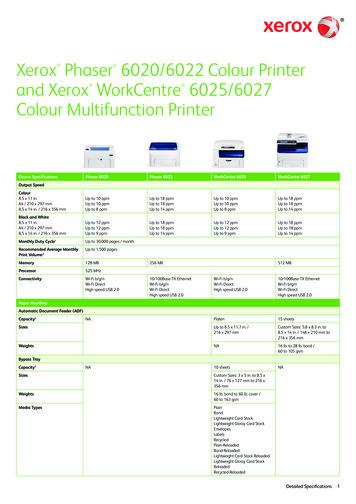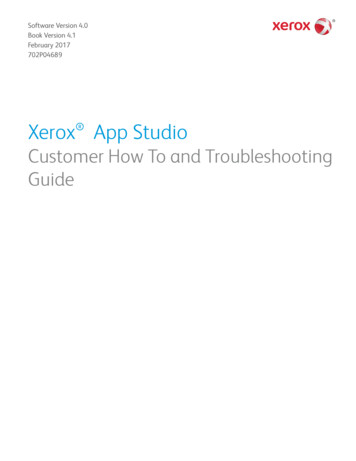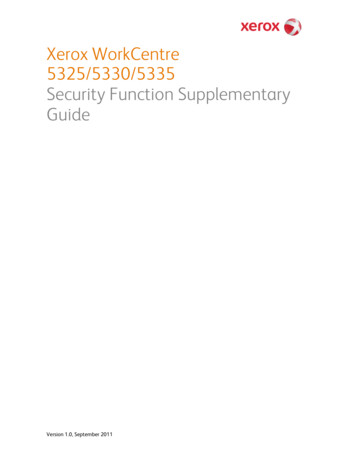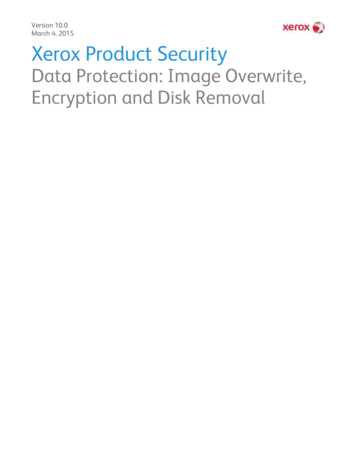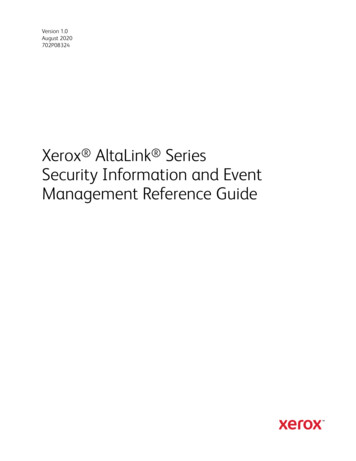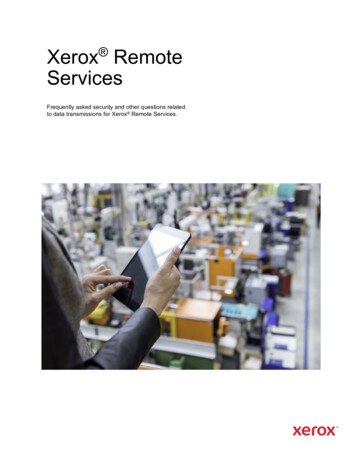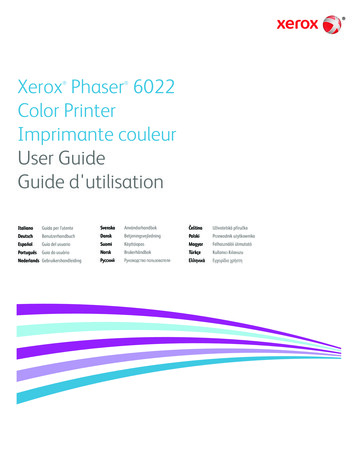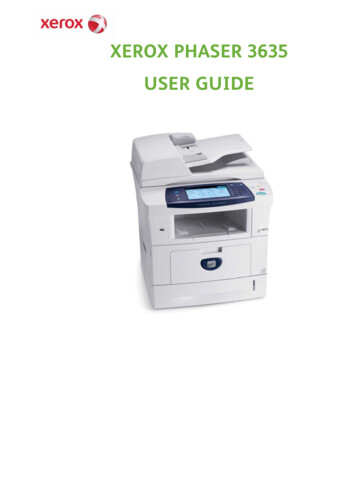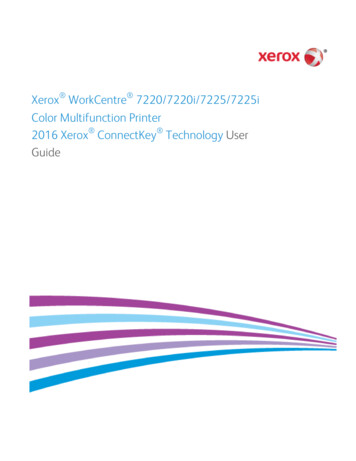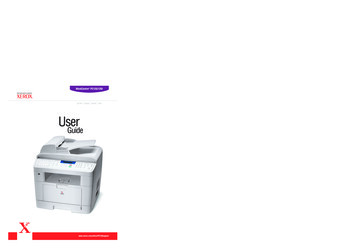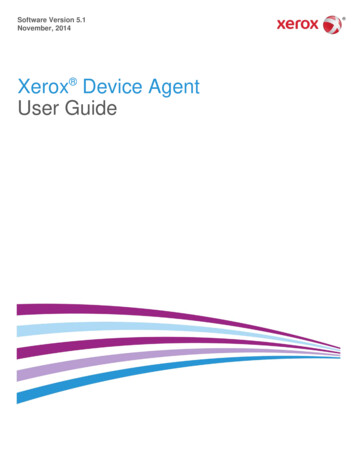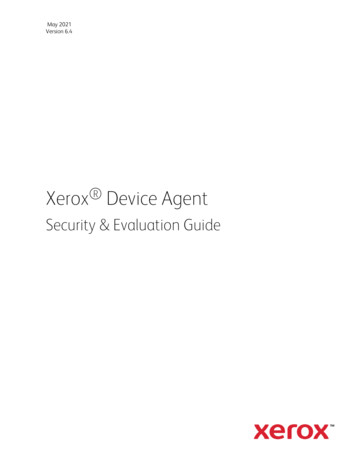
Transcription
May 2021Version 6.4Xerox Device AgentSecurity & Evaluation Guide
2021 Xerox Corporation. All rights reserved.Xerox , WorkCentre , and Phaser are trademarks of Xerox Corporation in the United States and/or othercounties. BR17445Microsoft , Windows , Windows Vista , SQL Server , Microsoft .NET, Windows Server , InternetExplorer , Access , and Windows NT are either registered trademarks or trademarks of MicrosoftCorporation in the United States and/or other countries.Linux is a registered trademark of Linus Torvalds.Apple , Macintosh , and MacOS are registered trademarks of Apple Inc.Parallels Desktop is a registered trademark of Parallels IP Holdings GmbH.Hewlett-Packard, JetDirect , and HP LaserJet are trademarks of Hewlett-Packard Development Company,L.P.UNIX is a registered trademark of The Open Group.VMWare is a registered trademark of VMware, Inc. in the United States and/or other jurisdictions.To ensure the efficient fulfillment of Xerox service offerings, we leverage global competency centers andcloud technology. This may result in the personal data we process being transferred beyond the EuropeanEconomic Area (EEA), but within the parameters of the defined service offering. The level of protectionafforded by General Data Protection Regulation (GDPR) is not undermined through data transfers, and alltransfers undertaken by Xerox are carried out in full compliance with GDPR using an approved mechanismand subject to appropriate safeguards.Changes are periodically made to this document. Changes, technical inaccuracies, and typographic errorswill be corrected in subsequent editions.Revision HistoryVersionDateDescription6.4May 2021Aligned Database Server requirements to read me. Reflect remote disablementand termination capability.6.3October 2020support for SQL Server 2019. Updated Mac requirements and unsupported configurations.6.2May 2020Changed CloudDM to CloudFMUpdated network traffic for auto update server queries6.1October 2019Added reference to Cloud DM in Auto update.6.0May 2019Support for Windows Server 2019. Remove references to Xerox Print Agent, whichis no longer supported. Update branding. Auto upgrade is now set to automaticby default. Ability to re-register device agents in Xerox Services Manager.5.6October 2018No change5.5May 2018Added note about personal data processing for GDPR. Updated hardware andsoftware requirements, added details about remote snmp v3 discovery, newrecovery services.5.4May 2017Updated supported browsers5.3February 2016Updates supported hardware and software requirements. Added support forMacintosh environments.5.2June 2015Updated recommended hardware and software requirements
Table of ContentsOverview and How to Use this Guide2Goals and Objectives2Intended Audience2Using This Guide2Limits to this Guide3Introduction to Xerox Device Agent4Product Overview4Deployment Requirements4Xerox Device Agent System Component Architecture4Recommended Hardware and Operating System Requirements5Requirements to Run on a Macintosh Operating System6Unsupported Configurations7Database Requirements7Browser Requirements7Printer Requirements7Network Printer Discovery/Monitoring Requirements7Direct Printer g9Post Install Normal OperationNetwork Printer1010SNMP v1-v2 Security10SNMP v3 Security10Xerox Back Office Integration11Device Information Communicated to Xerox12Xerox Device Agent Site Information Sent to Xerox12Xerox Services Manager Initiated Remote Commands to Xerox Device Agent13Xerox Device Agent Security & Evaluation Guidei
Xerox Device Agent Remote Configuration13Remote Disablement and Termination14Corporation Security Mode14Network Impact15Discovery15Device Discovery Method16IP Sweep Operation16Discover SNMP v3 Devices17Queue-based Discovery18Managing Discovery18Discovery Network Data CalculationsManufacturer ApplicabilityRecovery Services to Monitor for Errors182020Running Recovery Services20Disabling Recovery Services Automatic Upload21Xerox Services Manager Integration21Registration22Device List Import22Site Settings Export22Site Settings Import22Site Status Export22Device Information Export22Remote Command Check23Auto Update23Version CheckUpdate DownloadXerox Device Agent Security & Evaluation Guide2323ii
Tables and FiguresFigure 1: Typical Xerox Device Agent DeploymentTable 1: Printer Data Communicated to XeroxTable 2: Xerox Device Agent Site Information Sent to XeroxTable 5: Remote ConfigurationTable 6: Xerox Device Agent PortsTable 7: Data SizesTable 8: Data Gathering FrequenciesXerox Device Agent Security & Evaluation Guide5121314151919iii
Xerox Device Agent Security & Evaluation Guide1
Overview and How to Use this GuideOverview and How to Use this GuideGoals and ObjectivesNetwork and data security are one of the many challenges that businesses face on a daily basis.Recognizing this, Xerox continues to engineer and design all of its products to ensure the highest level ofsecurity possible.This document provides additional background on the Xerox Device Agent software capabilities, andspecifically focuses on the software’s security aspects. This document covers all Xerox Device Agentconfigurations, and some items may not apply to the version you have. This document will help you betterunderstand how the application functions and will help you feel confident that it transmits device data in asecure and accurate manner. This guide will help you certify, evaluate, and approve the deployment ofXerox Device Agent in support of your contract. It includes information on the application's potentialimpact on security and network infrastructure as well as calculations of theoretical network traffic.We recommend that you read this document in its entirety and take appropriate actions consistent withyour information technology security policies and practices. You have many issues to consider in developingand deploying a security policy within your organization. Since these requirements will vary from customerto customer, you have the final responsibility for all implementations, re-installations, and testing of securityconfigurations, patches, and modifications.Intended AudienceIt is expected that this guide will be used by your network administrator before installing Xerox DeviceAgent. In order to get the most from this guide, you should have an understanding of:lthe network environment where you will install Xerox Device Agent,lany restrictions placed on applications that are deployed on that network, andlthe Microsoft Windows operating systemUsing This GuideThere are two main scenarios for using this guide: if you are a customer who does not have acceptance andevaluation procedures for this type of software or if you are a customer who has defined guidelines. In bothcases, the three identified areas of concern are security, impact to the network infrastructure, and whatother resources might be required to install, use, and support Xerox Device Agent.Use this guide to gather information about these areas and determine if you need to investigate XeroxDevice Agent further. This document is divided into these areas:lThis overviewlAn introduction to Xerox Device AgentlPotential security-related impacts to a typical customer environment including:lSecurity information, implications, and recommendationslRoles and permission requirements of Xerox Device Agent usersXerox Device Agent Security & Evaluation Guide2
Overview and How to Use this GuidelInformation about features that impact the network, which may include estimates of generated traffic,changes to the network infrastructure, or other required resources.Limits to this GuideThis guide is meant to help you evaluate this application, but it cannot be a complete information sourcefor all potential customers. This guide proposes a hypothetical customer printer environment; if yournetwork environment differs from the hypothetical environment, your network administration team andXerox Support Representative must understand the differences and decide on any certificationmodifications and/or future steps. Additionally:llThis guide only describes those features within the application that have some discernable impact to theoverall customer network environment, whether it be the overall network, security, or other customerresources.The guide’s information is related to the application's current release. Although much of this informationwill remain constant through the software’s life cycle, some of the data is revision-specific, and will berevised periodically. IT organizations should check with the Xerox Support Representative to obtain theappropriate version.Xerox Device Agent Security & Evaluation Guide3
Introduction to Xerox Device AgentIntroduction to Xerox Device AgentProduct OverviewXerox Device Agent discovers and monitors printing devices, specifically office printers and multi-functiondevices.The application features a built-in alert detection system and has the capability to send an e-mail messageto an appropriate user when certain conditions exist in the monitored devices. It also provides clear andconcise status of all networked printers.You can do the following from Xerox Device Agent:lDiscover printerslNotify users via e-mail when faults occurlMonitor printers for status and alert conditionsThe application supports industry-SNMP MIBs for network printers; however, the amount and type ofmanagement that it can provide is dependent on the printer’s level of conformance to those standards. Thefollowing features conform to these standards:lPrinter identity (i.e. model, serial number, manufacturer, etc.)lPrinter properties (i.e. input trays, output bins, serial number, etc.)lTCP/IP protocol suite (SNMP, TCP, UDP, IP, NIC details)lSupported print protocols (LPD, HTTP, Port 9100)lConsumables and levels (toner, fuser, print cartridge and device unique parts)lPrinter status including overall state, detailed status, UI messages, etc.Note: A single instance of Xerox Device Agent supports a maximum of 2000 network print devices.Consumers with more than 2000 network print devices will install an additional instance of the applicationon a different server or PC to support the remaining networked print devices.Deployment RequirementsTo deploy the application install it on a desktop computer or server that has internet access and shares thenetwork with those printers that you want to monitor.Note: The scheduled events for meter reads and alert activity may be affected by the software'sconnectivity.Xerox Device Agent System Component ArchitectureThis diagram shows a typical configuration that a customer may deploy within their network. In thisexample, Xerox Device Agent runs on a networked computer that can access the printers through the localnetwork.Xerox Device Agent Security & Evaluation Guide4
Introduction to Xerox Device AgentFigure 1: Typical Xerox Device Agent DeploymentRecommended Hardware and Operating System RequirementsItemOperating System (32-bit and64-bit)RequirementlWindows Server 2012 and 2012 R2lWindows Server 2016lWindows Server 2019lWindows 8.1lWindows 10 Professional, Enterprise, HomelApple OS 10.9.4 or later when run with the Parallels Desktop hardware emulation software.Go to the Requirements to Run on a Macintosh Operating System section for requirementdetails.Microsoft .NET framework 4.5.2 Extended (Full Version) installedlSQL Server Compact EditionlSQL Server 2012 SP4lSQL Server 2014 SP3lSQL Server 2016 SP2lSQL Server 2017lDatabase ServerXerox Device Agent Security & Evaluation Guide5
Introduction to Xerox Device AgentItemRequirementlSQL Server 2019lThe software includes Microsoft SQL Server Compact Edition for operation.Windows 8.1, Windows 10, Windows Server 2012, Windows Server 2012 R2, WindowsServer 2016, Windows Server 2019: 2 GB of RAM (2.5 GB or higher recommended)MemorylProcessorl1.7 GHz processor or betterHard DisklMinimum free space is 450 MBl1024 x 768Minimum ResolutionPermissionsInternet ConnectionllYou must install the application software on the client computer using the administrativeaccount or an account with administrative privileges.RequiredNotes:lllllWe recommend that you update your host computers with the latest critical patches and service releasesfrom Microsoft Corporation.The Network Transmission Control Protocol/Internet Protocol (TCP/IP) must be loaded and operational.Requires SNMP-enabled devices and the ability to route SNMP over the network. It is not required toenable SNMP on the computer where the application will be installed or any other network computers.You must install Microsoft .NET framework 4.5.2 Extended (Full version) before you install the application.The application should not be installed on a PC where other SNMP-based applications or other Xeroxprinter management tools are installed, since they may interfere with each other's operation.Requirements to Run on a Macintosh Operating SystemThis table lists the system requirements that you must meet to run Xerox Device Agent in a Macintosh environment. You can only run Xerox Device Agent in a Macintosh environment by using hardware emulationsoftware. You cannot run Xerox Device Agent in a native Macintosh environment.ItemApple Mac HardwareHost Operating System for Apple Mac PlatformsHardware Emulation SoftwareRequirementlIntel Core 2 Duo, Core i3, Core i5, Core i7, or Xeon processorlApple OS 10.9.4 or laterllSupport Guest Windows Operating Systems Running a Parallels Desktop (32 and64-bit)Additional SoftwareParallels Desktop v10.2.1 or later required for Apple OS X 10.9 “Mavericks” – 10.10.x “Yosemite” host systemsParallels Desktop v11.0.1 or later required for Apple OS X 10.11 “ElCapitan host systemlWindows 8.1, and 8.1 update (64-bit only for update 1)lWindows 10lMicrosoft .NET framework 4.5.2 installedXerox Device Agent Security & Evaluation Guide6
Introduction to Xerox Device AgentItemRequirementMemorylHard Diskll2 GB for all Windows applicationsMinimum free space is 600 MB (100 MB for Xerox Device Agentand up to 500 MB for the Microsoft .NET framework, if not previously installed.)An additional 850 MB of disk space on the boot volume (MacintoshHD) for Parallels Desktop installationUnsupported ConfigurationslllllInstallation of the application on a computer with another Xerox device management application, suchas Xerox Device Manager.Installation of the application on a computer with other SNMP management tools,Native Mac OS operating system software (i.e., Xerox Device Agent can only run on the Apple MacPlatform when the Parallels Emulation Software is installed.)Any version of UNIX operating systems, Linux operating systems, Windows systems running theNovell client, Windows 7, Windows XP, Windows Vista, Windows NT 4.0, Windows Media Center,Windows 2000, Windows Server 2008, Windows Server 2008 R2, Windows Server 2003,Windows 8 RT, Operating systems running Terminal Services for applications and Installation on Windows systems running domain controllers.This application has only been tested on VMware Lab Manager /Workstation environments. Thisapplication may work on other virtual environments; however, these environments have not been testedDatabase RequirementsXerox Device Agent installs Microsoft SQL Server Compact 4.0 database engine and database files thatstore printer data and application settings within the installation directory. No additional licensing isrequired by the customer for the installation of this software product. Xerox Device Agent also supportsexisting instances of SQL Server, as described above.Browser RequirementsAlthough Xerox Device Agent is a Windows application that does not require a Web browser, whenaccessing back office systems that may be web-based (e.g., Xerox Services Manager) a Web browser maybe required.Printer RequirementsNetwork Printer Discovery/Monitoring RequirementsFor successful management by the application, all SNMP-based printer devices should support themandatory MIB elements and groups as defined by the following standards:lRFC 1157 (SNMP Version 1)lRFC 1213 (MIB-II for TCP/IP-based Internet)lRFC 2790 (Host Resources MIB v1/v2)lRFC 1759 (Printer MIB v 1)Xerox Device Agent Security & Evaluation Guide7
Introduction to Xerox Device AgentlRFC 3805 (Printer MIB v 2)lRFC 3806 (Printer Finishing MIB)Direct Printer RequirementsQueue-based discovery depends on user permissions on domain and/or across computers, NetBIOS File andPrinter Sharing, Network Discovery, and WMI.Xerox Device Agent Security & Evaluation Guide8
SecuritySince security is an important consideration when evaluating tools of this class, this section providesinformation about the security methods used by Xerox Device Agent.ApplicationThe application is compatible with the security features built into the Windows operating systems. Itrelies on a background Windows service running under the local system account credentials to enableproactive monitoring of printers, gathering of data, and submission to Xerox Services Manager. The userinterface that displays the gathered data is accessible only to the power users and administrators who havelogin access to the Windows operating system.InstallThe installer requires administrator privileges. The Windows service, “Xerox Device Agent Service” isinstalled and configured to run under the local system Windows account. No special system levelconfiguration change is required or made by the installer. Xerox Device Agent is compatible with thesecurity features built into the Windows operating system including:lUser authentication and authorizationlGroup policy deployment and managementlInternet Connection Firewall (ICF) including:- Security logging settings- ICMP settingsNote: Make sure that the PC or server that is running Xerox Device Agent is continuously powered on duringcore business hours to prevent interruption of automatic communications between Xerox Device Agent andXerox.LicensingThe customer must accept the End User License Agreement (EULA) that is presented upon Xerox DeviceAgent installation. No additional licensing is required by the customer for installation of the Microsoft SQLServer Compact 4 .database.Note: This section only applies to Xerox Print Services and Xerox Partner Print Services.To successfully operate Xerox Device Agent, you must have a Xerox services contract and an account onXerox Services Manager. During the software configuration process, you will need to pair Xerox DeviceAgent with an Xerox Services Manager account in order to activate Xerox Device Agent. For this reason, youare required to use a Xerox Services Manager registration key supplied by Xerox or your service provider.Depending on your account, you may also be required to use a secondary registration key.Xerox Device Agent Security & Evaluation Guide9
SecurityPost Install Normal OperationThe Xerox Device Agent Windows service runs as a background process even when no user is logged in. Thisenables the application to monitor the devices on the network and generate alerts proactively. If you are apower user or an administrator authenticated by Windows and you log in to the system, then you haveaccess to the Xerox Device Agent’s user interface. You can monitor the printers, view printer data, andchange settings. The application's user interface verifies that you are a power user or you haveadministrative privilege as you attempt to run the application. If you are not an administrator, theapplication will display a message that states you need administrative privileges in order to run theapplication.Network PrinterThe Simple Network Management Protocol (SNMP) is the most widely-used-network-management tool forcommunication between network management systems and the networked printers. The applicationutilizes SNMP during discovery operations to retrieve detailed data from output devices detected on thenetwork. After dis
Xerox Device Agent discovers and monitors printing devices, specifically office printers and multi-function devices. The application features a built-in alert detection system and has the capability to send an e-mail message to an appropriate user when certain conditions exist in the monitored devices. It File Size: 341KB
